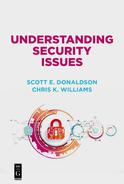Contents
How Do Security Professionals Think about Security?
Chapter 2:Common Cybersecurity Attacks
What Are the Cyberattackers Trying to Do?
What Is the Value of Hacking You?
What Is the Value of Hacking Your Workplace?
How Do the Cyberattackers Attack?
Chapter 3:Protecting Your Computer(s)
Securing Your Operating System
Using Antimalware Protection and Personal Firewall
Limiting Administrative Privileges
Backing Up Your Operating System
Watching for Signs of Compromise
Using Mac and Linux Operating Systems
Chapter 4:Protecting Your Passwords
How Do Cyberattackers Get Your Password?
Create Good Passwords and Passphrases
Understand Password Reset Mechanisms
Use Multifactor Authentication
Chapter 5:Protecting Your Home Network
Checking Your Network Modem, Router, and Firewall
Securing Your Wi-Fi Configuration
Supporting Visitors and Guests
Configuring Multimedia and Gaming Consoles
Protecting Home Internet of Things Devices and Smart Locks
Understanding Remote Access and Running Your Own Servers
Chapter 6:Smartphones and Tablets
Smartphone and Tablet Differences
Protecting Your Smartphone or Tablet
Addressing Mobile Operating System Vulnerabilities
Addressing Smartphone or Tablet “Rooting”
Reducing Smartphone or Tablet Malicious Apps Risk
Securing Bluetooth and Wi-Fi Networking
Protecting Your Smartphone and Tablet Location Privacy
Using SMS-Based Messaging and Authentication Safely
Using BYOD and Mobile Device Management
Chapter 7:Protecting Your Web Browsing
Using Web Communication Protocols: HTTP versus HTTPS
Avoiding Malicious Sites, Malvertising, and Pop-Ups
Using Web Browser Security and Plug-Ins
Protecting Your Browsing History
Chapter 8:Protecting Your E-Mail and Phone Calls
Preventing Unauthorized Access to Your E-Mail Account
Recognizing Phishing, Spear Phishing, and Online Scams
Guarding Against Counterfeit E-Mails and Secure E-Mail
Guarding Against Unsolicited Phone Calls
Chapter 9:Protecting Your Identity, Privacy, and Family Online
Controlling Your Anonymity Online
Protecting Your Identity and Credit
Safely Using E-Mail, Social Media, and Gaming
Reducing Risk of Online Shopping, Credit Cards, Banking, and Automated Teller Machines
Protecting Online Medical Privacy
Understanding Net Neutrality, HIPAA, and GDPR
Chapter 10:Protecting Yourself on Travel
Selecting What to Take When You Travel
Considering Backups and Contingencies for Travel
Using Kiosk Computers and Public Internet Connections
Considering Physical Protection, Personal Safety, and Electricity
Being Cautious about Conversations and Online Sensitive Data
Protecting Your Hard Drive and Mobile Media with Encryption
Reducing the Risk of USB Connections
Considering Diplomacy, ITAR, EAR, and Security Clearances
Chapter 11:When Things Go Wrong
Recognizing Account Compromise
Responding to Online Personal Attacks
Resetting Your Compromised Computer or Device
Reporting Work Cyber Incidents
Understanding the Risks of Being Paperless
Chapter 12:Considering Cybersecurity at Work
Enterprise Cybersecurity Differences
Enterprise Network Perimeter and Security
Endpoint Hardening and Encryption
Identity and Access Management
Remote Access to Enterprise IT Resources
Personnel Cybersecurity Training
Cybersecurity Operations and Incident Response
Physical Security and Personnel Protection
Business Continuity and Disaster Recovery
Appendix A:Common Online Scams
Common Characteristics of Phishing E-Mails
Common Subject Lines for Malicious E-Mails
Watching Out for Scams and Scam Sites
Antivirus and Tech Support Scams
Internal Revenue Service (IRS) Scam
Medicare and Social Security Scams
Natural Disaster and Charity Scams
Appendix B:The Worst Passwords Ever
